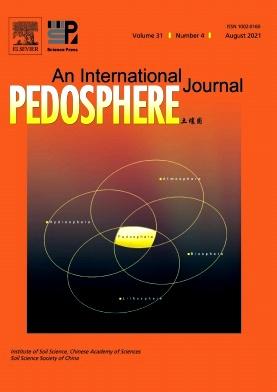以协同增效的方式施用稻壳提取的硅,减轻稻谷对砷的吸收和积累:盆栽和田间试验的证据
IF 7.3
2区 农林科学
Q1 SOIL SCIENCE
引用次数: 0
摘要
水稻土壤中的砷污染对亚洲水稻生产构成了严重威胁。从富含硅的燃烧稻壳(CRH)中回收硅(Si)可以作为一种可持续的策略,通过它们的共享运输途径来减少水稻对硅的吸收。单在根(土)中施用CRH不足以使精米中的无机砷(iAs)降至中国食品标准(0.2 mg kg-1)以下。在本研究中,从CRH中提取的硅水溶液在水稻对硅的需求最高的时期(繁殖期)进行叶面协同施用,然后在根系上施用硅,以研究水稻对砷的吸收。在盆栽试验中,在根施CRH的基础上,与单根施CRH相比,水稻生育期前补硅导致根表面砷浓度降低51%,同时由于根分化增强,铁斑块明显减少。同时,根中OsLis6基因的表达比仅根施CRH时下调了91%。与CRH处理相比,这些变化减少了56%的As流入根部,相应地导致41%的As转移到秸秆。在节点1中,OsLis6的表达同时下降了71%,最终导致籽粒中iAs积累量比单根施用CRH时降低了28%。在田间试验中,单叶面施硅,仅在较低的土壤砷水平(40 mg kg-1)下才减缓了稻谷内砷的释放,而在较高的土壤砷水平(80 mg kg-1)下,相对于不施硅的对照,稻谷内砷的释放有促进作用。综上所述,CRH对水稻砷积累的缓解作用可以通过叶面硅的协同供应得到关键加强,是砷污染稻田保障水稻生产的更可靠途径。本文章由计算机程序翻译,如有差异,请以英文原文为准。
Mitigation of arsenic uptake and accumulation in rice grains by applying husk-derived silicon in a synergistic way: Evidence from pot and field trials
Arsenic (As) contamination in paddy soils has posed a prominent threat to rice production in Asia. Recycling of silicon (Si) from Si-rich combusted rice husk (CRH) could serve as a sustainable strategy to mitigate rice As uptake through their shared transport pathway. Root (soil) application of CRH alone, however, was insufficient to decrease inorganic As (iAs) in polished rice below Chinese food standards (0.2 mg kg-1). In this study, an aqueous Si solution derived from CRH was used for synergistic foliar application over the highest Si-demanding stage (reproductive stage) of rice, following root application of Si, to investigate rice As uptake in both pot and field experiments. In the pot experiment, on the basis of root application of CRH, Si supplementation before the reproductive stage of rice led to a 51% decrease in As concentration on root surface along with a prominent reduction of Fe plaque due to enhanced root suberization, relative to single root application of CRH treatment. In parallel, the expression of OsLis6 gene in the root was downregulated by 91% than that with only root application of CRH. These changes decreased As influx into root by 56% and led correspondingly to 41% lower As transfer to the straw, as compared with root application of CRH treatment. In node I, the expression of OsLis6 decreased concurrently by 71%, leading ultimately to 28% lower iAs accumulation in grains than that with root application of CRH alone. In the field experiment, with single foliar Si, the mitigation of grain iAs occurred only at lower soil As level of 40 mg kg-1, while promoted iAs unloading into grains was determined under higher soil As level (80 mg kg-1) relative to the control without Si application. It was, therefore, concluded that the mitigation of grain iAs accumulation with soil application of CRH can be strengthened critically by synergistic supply of foliar Si, serving as a more reliable pathway to secure rice production in As-contaminated paddy fields.
求助全文
通过发布文献求助,成功后即可免费获取论文全文。
去求助
来源期刊

Pedosphere
环境科学-土壤科学
CiteScore
11.70
自引率
1.80%
发文量
147
审稿时长
5.0 months
期刊介绍:
PEDOSPHERE—a peer-reviewed international journal published bimonthly in English—welcomes submissions from scientists around the world under a broad scope of topics relevant to timely, high quality original research findings, especially up-to-date achievements and advances in the entire field of soil science studies dealing with environmental science, ecology, agriculture, bioscience, geoscience, forestry, etc. It publishes mainly original research articles as well as some reviews, mini reviews, short communications and special issues.
 求助内容:
求助内容: 应助结果提醒方式:
应助结果提醒方式:


